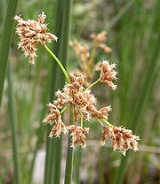
Schoenoplectus californicus
Encyclopedia
Schoeneoplectus californicus is a species of sedge
known by the common names California bulrush and giant bulrush. It is also sometimes called "tule", but the closely related Schoenoplectus acutus
is the more correct owner of that name.
d water plant found in marshy areas from southern and western North America
to South America
and on Pacific islands including some of those in the Hawaii
an and Cook chains
. It has tall, thin, dark green stems which are usually triangular in cross-section and woolly, bristly tan or brown flowers in panicle inflorescences
.
is the Totora
, Schoenoplectus californicus ssp. tatora. This is famous for making up the floating islands on which the Uros
people of Lake Titicaca
dwell, as well as occurring on isolated Easter Island
in the Pacific.
Cyperaceae
Cyperaceae are a family of monocotyledonous graminoid flowering plants known as sedges, which superficially resemble grasses or rushes. The family is large, with some 5,500 species described in about 109 genera. These species are widely distributed, with the centers of diversity for the group...
known by the common names California bulrush and giant bulrush. It is also sometimes called "tule", but the closely related Schoenoplectus acutus
Tule
Schoenoplectus acutus , called tule , common tule, hardstem tule, tule rush, hardstem bulrush, or viscid bulrush, is a giant species of sedge in the plant family Cyperaceae, native to freshwater marshes all over North America...
is the more correct owner of that name.
Description
Schoeneoplectus californicus is a rhizomeRhizome
In botany and dendrology, a rhizome is a characteristically horizontal stem of a plant that is usually found underground, often sending out roots and shoots from its nodes...
d water plant found in marshy areas from southern and western North America
North America
North America is a continent wholly within the Northern Hemisphere and almost wholly within the Western Hemisphere. It is also considered a northern subcontinent of the Americas...
to South America
South America
South America is a continent situated in the Western Hemisphere, mostly in the Southern Hemisphere, with a relatively small portion in the Northern Hemisphere. The continent is also considered a subcontinent of the Americas. It is bordered on the west by the Pacific Ocean and on the north and east...
and on Pacific islands including some of those in the Hawaii
Hawaii
Hawaii is the newest of the 50 U.S. states , and is the only U.S. state made up entirely of islands. It is the northernmost island group in Polynesia, occupying most of an archipelago in the central Pacific Ocean, southwest of the continental United States, southeast of Japan, and northeast of...
an and Cook chains
Cook Islands
The Cook Islands is a self-governing parliamentary democracy in the South Pacific Ocean in free association with New Zealand...
. It has tall, thin, dark green stems which are usually triangular in cross-section and woolly, bristly tan or brown flowers in panicle inflorescences
Panicle
A panicle is a compound raceme, a loose, much-branched indeterminate inflorescence with pedicellate flowers attached along the secondary branches; in other words, a branched cluster of flowers in which the branches are racemes....
.
Uses
A notable subspeciesSubspecies
Subspecies in biological classification, is either a taxonomic rank subordinate to species, ora taxonomic unit in that rank . A subspecies cannot be recognized in isolation: a species will either be recognized as having no subspecies at all or two or more, never just one...
is the Totora
Totora (plant)
Totora is a subspecies of the giant bulrush sedge. It is found in South America - notably on Lake Titicaca, the middle coast of Perú and on Easter Island in the Pacific Ocean...
, Schoenoplectus californicus ssp. tatora. This is famous for making up the floating islands on which the Uros
Uros
The Uros are a pre-Incan people who live on forty-two self-fashioned floating islands in Lake Titicaca Puno, Peru and Bolivia. They form three main groups: Uru-Chipayas, Uru-Muratos and the Uru-Iruitos...
people of Lake Titicaca
Lake Titicaca
Lake Titicaca is a lake located on the border of Peru and Bolivia. It sits 3,811 m above sea level, making it the highest commercially navigable lake in the world...
dwell, as well as occurring on isolated Easter Island
Easter Island
Easter Island is a Polynesian island in the southeastern Pacific Ocean, at the southeasternmost point of the Polynesian triangle. A special territory of Chile that was annexed in 1888, Easter Island is famous for its 887 extant monumental statues, called moai, created by the early Rapanui people...
in the Pacific.
Synonyms
Obsolete scientific names for this plant include:- Dichromena atrosanguinea
- Elytrospermum californicus
- Malacochaete assimilis
- Malacochaete chilense
- Malacochaete oligostachya
- Malacochaete riparia
- Malacochaete sanguinolenta
- Malacochaete tatora (for ssp. tatora)
- Schoenoplectus riparius
- Schoenoplectus tatora (for ssp. tatora)
- Schoenoplectus totora (lapsusLapsusA lapsus is an involuntary mistake made while writing or speaking. According to Freud's early psychoanalytic theory, a lapsus represents a missed deed that hides an unconscious desire....
, for ssp. tatora) - Scirpus californicus
- Scirpus chamissonis (for var. chamissonis)
- Scirpus decipiens
- Scirpus pseudotriquetes
- Scirpus rigidus
- Scirpus riparius
- Scirpus tereticulmis (for var. tereticulmis)

